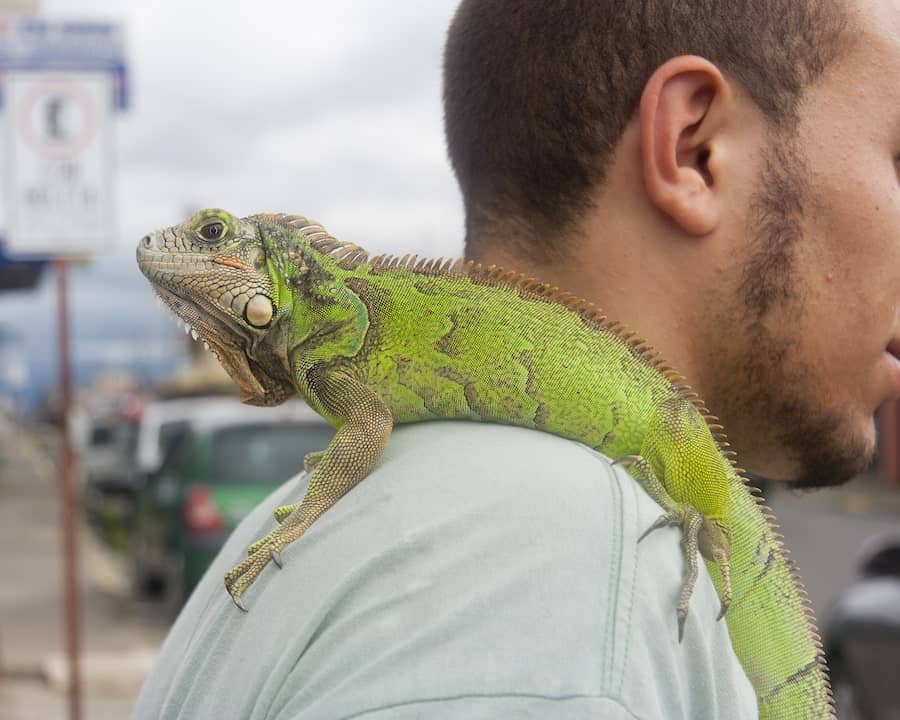There are 35 iguana species that are officially recognized. However, some iguanas make better pets than others.
In this article, I’m going to outline the 5 best pet iguanas for anyone who wants their own reptile. I’ll be covering: green, rhino, spiny tail, desert and blue iguanas in this guide.
With the right care, these five species of iguanas make for a great, fun companion.
Factors Used to Rank the Best Pet Iguana

I’ve used multiple factors to rank the best pet iguana, including:
Cost to Purchase
How much will it cost to purchase an iguana? Iguanas require a lot of care – more than most people realize. I used the cost to purchase the pet when adding the five species to this list.
I wrote an article titled “Cost of Owning an Iguana in 2022 & How to Save,” which I recommend reading if you plan on buying an iguana. It’s an insightful guide on owning an iguana.
Tamable

I’ve provided a range of easy, medium or hard to help you better understand how easy it is or possible to handle the iguana species in question.
I recommend that anyone who buys an iguana for the first time read my article regarding how to tame an iguana by clicking the link.
Size

Some iguanas get big – very big. You may need a larger enclosure or space to hold your reptile.
Difficulty Keeping Alive
I also used a difficulty rating of easy, medium or hard for the overall ability to keep the iguana species alive.
1. Green Iguana

- Cost to Purchase: $20 – $600
- Tamable: Medium
- Size: 6.6-feet maximum
- Difficulty Keeping Alive: Medium
Green iguanas are the most common species for pet owners to buy, and they’re great companions. I do want to state that every iguana is different, and this is why I gave these iguanas a medium tamable level.
One of the difficulties of owning an iguana is getting the reptile to trust you.
Trust takes a lot of time for an iguana, and it can be easily broken. A perfect balance of consistency and patience is necessary when owning a green iguana – or any species.
Green iguanas have a lifespan of 12 – 15 years, but with the right care, you may have a healthy reptile that lives for 20 years.
Proper care is necessary. Unfortunately, a lot of new owners find their pet dies within a few years.
Owning an iguana is rewarding, but if you cannot dedicate the time and resources to creating the right environment for your pet or caring for them, they may not be a good companion for you.
First-time owners are encouraged to read through my guides on this site and have a veterinarian examine their iguana every few months. The vet will shed light on issues with:
- Malnourishment
- Dehydration
- Care
While difficult to care for properly, owning an iguana can be extremely rewarding.
2. Rhino Iguana

- Cost to Purchase: $550 – $800+
- Tamable: Easy
- Size: 4.5-feet
- Difficulty Keeping Alive: Difficult
Rhino iguanas make for one of the easiest pet iguanas, and they tend to be calmer than even their green counterparts. However, some of these reptiles are more difficult to train than others.
Interestingly, many owners find that if the rhino is three or more generations into being a captive-bred iguana, they’re usually easier to train.
With that in mind, you can keep your reptile for up to 20+ years if you care for him properly, so it’s worth the initial investment in training them.
These iguanas are native to:
- Islands
- Dominican Republic
- Haiti
- Hispaniola
Due to their natural habitat, you’ll need to keep their environment very humid (70 – 80%) and you’ll need a large enclosure for them.
However, there is something that needs to be addressed immediately. You must purchase a rhino iguana from a breeder because these reptiles are at a major risk of going extinct.
It’s very important that you respect this purchasing process and never buy a rhino iguana from a non-breeder. You don’t want to be part of the problem that is causing these beautiful iguanas to remain at risk of extinction.
Rhino iguanas are considered high-maintenance, and they take up to three years to reach their full size. Additionally, they have a very strong bite.
While they are easy to care for, they are still not the best choice for beginners.
Improper humidity, heat and nutrition can all impact this iguana’s lifespan.
Due to the high heat and humidity requirements of this species, they can be quite expensive to keep compared to some of the other species on this list.
3. Spiny Tail Iguana

- Cost to Purchase: $150+
- Tamable: Medium
- Size: 10” – 5’
- Difficulty Keeping Alive: Medium
Spiny tail iguanas are native to Central America and Mexico. They can easily live to be 15 years old or older, and their sizes can vary depending on the type.
The Yucatan spiny tailed iguana, for example, grows to be just 10” long. The black spiny tail, on the other hand, can reach 5’ in length.
Outdoor enclosures in sunny, hot locations are best for these lizards. However, they still thrive in indoor enclosures with the right lighting setup.
One thing that’s important to note is that these lizards do have a reputation for being ill-tempered. With time and patience, they may eat from your hand or tolerate gentle handling. However, many people choose to keep these lizards as display animals.
If you want a spiny tail iguana as a pet, make sure that you purchase a captive-born-and-bred iguana. Captive iguanas tend to be hardier and less skittish compared to wild ones.
Also, the wild population of spiny tail iguanas are on the decline because of hunting, loss of habitat and other issues. So, finding a lizard that is born and bred in captivity will help reduce the impact on the wild population.
4. Desert Iguana

- Cost to Purchase: $30-$75
- Tamable: Hard
- Size: 18”
- Difficulty Keeping Alive: Medium
The desert iguana is native to the Southwestern U.S. and Mexico. In the U.S., this lizard is commonly found in Arizona, Southern California, Utah and Nevada.
Compared to other types, the desert iguana is fairly docile and can be accustomed to handling.
The desert iguana is actually very hardy in captivity as long as they receive proper care – i.e., a warm (90 F) and bright enclosure.
Despite their hardiness, these iguanas aren’t easy to find through dealers. They show up on stock lists occasionally, but you may have better luck finding one through a reputable online forum.
Owners may be looking to sell their pets or their hatchlings.
As always, make sure that you’re sourcing your iguana from a reputable source. If you’re purchasing someone’s pet, make sure that it’s healthy before committing to caring for it.
5. Blue Iguana

- Cost to Purchase: $200+
- Tamable: Medium
- Size: 5+ Feet long; 25+ lbs.
- Difficulty Keeping Alive: Medium
Blue Iguanas are quite adaptable. Their long lifespans and beautiful coloring make them a popular choice for pets.
The blue coloring is more prominent in males, but females still have attractive coloring.
Blue iguanas can grow to be quite large – as long as 5’ or more. If you want to keep one as a pet, it’s important to keep its large size in mind. They can also live for decades, so choosing a suitable enclosure is critical.
While they can technically be housed indoors, their large size makes an outdoor enclosure more practical.
These iguanas are readily available for purchase, but choosing a reputable source for your pet is important.
Many iguana keepers find that blue iguanas are a little more docile than green iguanas. However, they are still not pets for beginners.
That said, if you’re ready for an iguana, you may find that its blue coloring and calmer nature make them a suitable choice for you.
Can Galapagos Island Iguanas be Kept as Pets?

Iguanas that are native to the Galapagos Islands are known as marine iguanas. They’re gorgeous creatures with a naturally long lifespan of 60 years. But can they be kept as pets?
Marine iguanas generally do not make good pets. They aren’t known for being friendly and can be exceptionally hard to take care of. Galapagos Islands iguanas that aren’t cared for properly have a very high risk of dying.
It’s important to remember that these iguanas live on the shores of the Galapagos Islands. They live in the shallow reef and along the rocky coastline. Therefore, recreating their natural environment can be incredibly difficult.
Their diet consists primarily of seaweed and algae, which presents another challenge for keeping them as pets.
Many marine iguanas are also considered endangered or vulnerable.
In other words, it’s best to leave these guys in their natural habitats and appreciate them from afar.
Final Thoughts
Iguanas are fascinating creatures and can really make for interesting pets. But they’re not for everyone.
I recently wrote a post called “Are Iguanas Good Pets For Beginners” Here’s Why Not” that sheds some light on why these pets aren’t the best choice for every person.
However, if you are ready for an iguana and the joy of owning one, these five species are great options.

